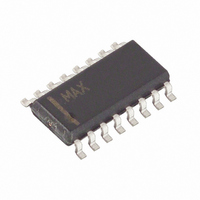MAX912CSE+ Maxim Integrated Products, MAX912CSE+ Datasheet - Page 7

MAX912CSE+
Manufacturer Part Number
MAX912CSE+
Description
IC COMPARATOR LP 16-SOIC
Manufacturer
Maxim Integrated Products
Type
with Latchr
Datasheet
1.MAX913CSA.pdf
(11 pages)
Specifications of MAX912CSE+
Number Of Elements
2
Output Type
Complementary, TTL
Mounting Type
Surface Mount
Package / Case
16-SOIC (0.154", 3.90mm Width)
Number Of Channels
2 Channels
Supply Voltage (max)
7 V
Supply Voltage (min)
- 7 V
Supply Current (max)
10 mA
Maximum Operating Temperature
+ 70 C
Mounting Style
SMD/SMT
Minimum Operating Temperature
0 C
Propagation Delay Time
16 ns
Comparator Type
Precision
No. Of Comparators
2
Response Time
10ns
Ic Output Type
TTL
Supply Current
6mA
Supply Voltage Range
4.5V To 5.5V, -2V To -7V
Amplifier Case Style
SOIC
Rohs Compliant
Yes
Lead Free Status / RoHS Status
Lead free / RoHS Compliant
The MAX912 (dual) and MAX913 (single) high-speed
comparators have a unique design that prevents oscil-
lation when the comparator is in its linear region. No
minimum input slew rate is required.
Many high-speed comparators oscillate in the linear
region, as shown in the Typical Operating Characteris-
tics’ industry-standard 686 response graph. One way
to overcome this oscillation is to sample the output after
it has passed through the unstable region. Another
practical solution is to add hysteresis. Either solution
results in a loss of resolution and bandwidth.
Because the MAX912/MAX913 do not need hysteresis,
they offer high resolution to all signals—including low-
frequency signals.
The MAX912/MAX913 provide a TTL-compatible latch
function that holds the comparator output state
As long as Latch Enable (LE) is high or floating, the input
signal has no effect on the output state. With LE low, the
outputs are controlled by the input differential voltage
and the latch is transparent.
A comparator can be thought of as having two sec-
tions; an input amplifier and a logic interface. The
MAX912/MAX913’s input amplifier is fully differential
with input offset voltage trimmed to below 2.0mV at
Figure
1. Timing Diagram
(DIFFERENTIAL)
_______________________________________________________________________________________
ENABLE (LE)
Detailed Description
LATCH
V
IN
Q
Q
Single/Dual, Ultra-Fast, Low-Power
t
Input Amplifier
PD-
t
PD+
(Figure
t
PD
Precision TTL Comparators
t
SU
1).
t
H
+25°C. Input common-mode range extends from
200mV below the negative supply rail to 1.5V below
the positive power supply. The total common-mode
range is 8.7V when operating from ±5VDC supplies.
The MAX912/MAX913’s amplifier has no built-in hys-
teresis. For highest accuracy, do not add hysteresis.
Figure
A comparator’s ability to resolve small signal differ-
ences—its resolution—is affected by various factors.
As with most amplifiers, the most significant factors are
the input offset voltage (V
and power-supply rejection ratios (CMRR, PSRR). If
source impedance is high, input offset current can be
significant. If source impedance is unbalanced, the
input bias current can introduce another error.
For high-speed comparators, an additional factor in
resolution is the comparator’s stability in its linear
region. Many high-speed comparators are useless in
their linear region because they oscillate. This makes
the differential input voltage region around 0V unus-
able, as does a high V
problem, but acts to keep the input away from its linear
range
The MAX912/MAX913 do not oscillate in the linear
region, which greatly enhances the comparator’s reso-
lution.
t
LPD
(Figure
2 shows how hysteresis degrades resolution.
2).
OS
. Hysteresis does not cure the
OS
) and the common-mode
Resolution
7











